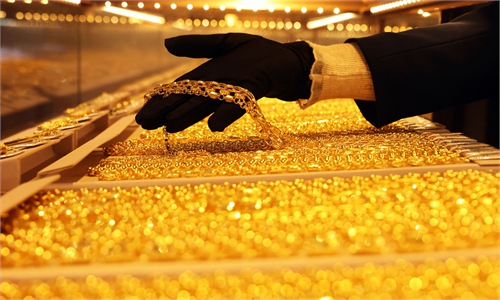
A staff member organizes gold jewelry at a gold store in Huzhou city, East China's Zhejiang Province on April 3, 2024. Photo: VCG
Prices of spot gold and futures have reached a new high on Wednesday. Facing a rapidly evolving global economy, gold, a traditional safe haven asset, has again become the focus of the market.
Although the gold price has recently crashed after hitting a historical high, industry experts generally believe that the price rise is not accidental, and in the near future, there is further room for the price to climb even higher.
By 4 pm (Beijing time) on Wednesday, the price of gold futures in the international market reached $2,480.1 per ounce, up 0.5 percent.
At China's domestic market, the main contract of Shanghai gold futures closed higher at 581.56 yuan ($80.06) per gram (approximately $2,270 per ounce), up 1.54 percent from previous trading session. At one point, it rose to 585.84 yuan per gram.
The price of gold in several jewelry brands broke through the 750-yuan ($103) per gram mark on Wednesday, the Global Times has learned.
A Beijing-based 65-year-old resident surnamed Li told the Global Times on Wednesday that she rushed to a gold shop and bought 20 grams of gold on Tuesday. Li regretted for not having bought more.
"I bought gold products every year as part of the family's wealth management. I can remember the price went up from about 300 yuan per gram in 2019 to more than 700 yuan now. I should have bought more," Li said.
Many customers have inquired about gold during recent months and the majority of the customers bought some gold products, a manager at a major Chinese bank, who requested not to be named, told the Global Times on Wednesday.
In the first quarter of 2024, the demand for gold bars and coins in the Chinese market reached 110.5 tons, a surge of 68 percent year-on-year, marking the strongest first-quarter performance since 2013, data from the World Gold Council showed.
Since March 2024, gold prices continued to rise and quickly broke through the $2,400 per ounce mark. Gold COMEX, the world's leading benchmark futures contract, has risen 19.39 percent to date since the beginning of 2024, and London Spot Gold has risen 19.68 percent, according to industry statistics.
The US inflation concerns have lately weakened, and the Federal Reserve's interest rate cut expectations have strengthened, significantly supporting the price of precious metals, analysts said.
Looking ahead, although gold prices are hitting historic highs, there is still plenty of room for further growth, given the uncertainties in the global economy, the likelihood that monetary easing will continue in many countries which may spur inflation, industry observers said.
According to a forecast report by the Bank of America Chief Investment Office, the price of gold might hit the $3,000 per ounce in the next 12 to 18 months. "Achieving this lofty price will largely depend on an uptick in non-commercial demand."
Currently, non-commercial purchases have upheld an average gold price of around $2,200 per ounce year-to-date. However, a substantial rise in investment demand could spur prices to edge higher to $3,000, read the forecast report.
A recent survey conducted by the World Gold Council supports the analysis of a rising gold price, pointing to a strong willingness by central banks to increase their gold reserves.
The survey of central banks found that the top three reasons for their holdings of gold are: interest rates (96 percent), concerns about inflation (86 percent) and geopolitical instability (72 percent).
Regarding the changing proportion of gold in reserves over the next 5 years, 66 percent of central banks surveyed by the World Gold Council said their gold reserves could be moderately higher, with 3 percent expecting the reserves to be significantly higher.
Global Times


